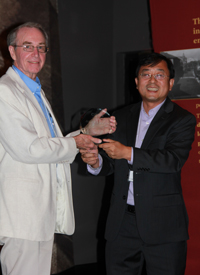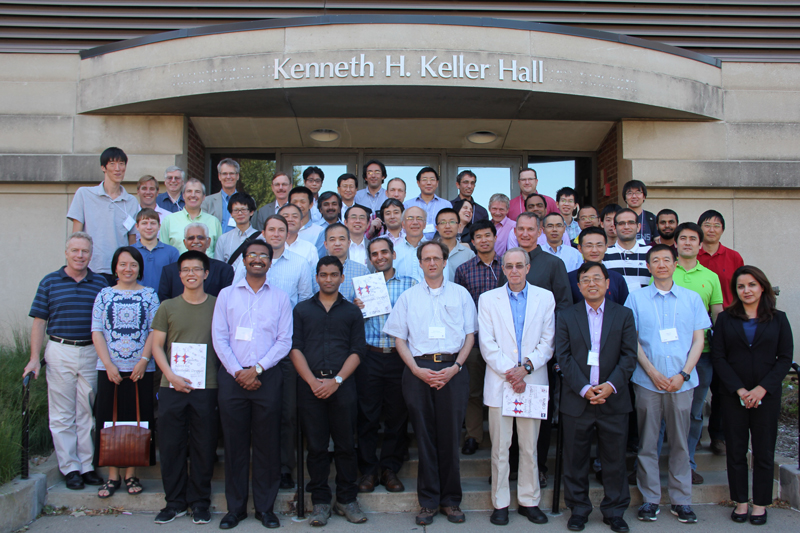Heusler Alloys for Spintronic Devices Workshop Summary
 William Butler and Jian-Ping Wang
William Butler and Jian-Ping Wang
Sometime around 1900, an obscure German chemist noticed something unusual. Having grown up around his father’s small metalworks factory, Friedrich Heusler knew that an alloy of three non-magnetic metals shouldn’t be magnetic. But when he put copper, tin, and manganese together, the first “Heusler alloy” was born. Nearly 115 years after this discovery, over 1000 possible Heusler alloys have been identified and dozens have been fabricated and tested. These alloys are potential semiconductors, ferromagnets, antiferromagnets, superconductors, and topological insulators.
Last month, 18 top scientists from the United States, Germany, Japan and Great Britain gathered at the University of Minnesota to discuss Heusler alloys and their application to spintronic devices. Another 20 industry participants from semiconductor industry giants (such as Intel, Seagate, and Western Digital) and startups (such as Spin Transfer Tech) also participated. More than 20 C-SPIN students and postdoctoral fellows attended the workshop on site, and several C-SPIN industry associates joined the workshop online.
STARnet program executive director Gil Vandentop and DARPA STARnet program director Avram Bar-Cohen gave kickoff speeches, expressing the urgent need for new materials and the importance of the Heusler workshop to STARnet and future DARPA programs. C-SPIN director Jian-Ping Wang gave a short introduction to C-SPIN and the importance of Heusler alloy research to C-SPIN and future nanoelectronics.
The workshop began with a plenary talk by Intel researcher Ian Young, a world leader in benchmarking CMOS and beyond-CMOS devices. He primarily discussed the promise of perpendicular spintronic devices containing Heusler alloys. He also presented a benchmarking chart that positioned some perpendicular spintronic devices on par with future CMOS devices in terms of energy and delay product.
Young’s presentation was followed by 17 formal presentations covering all aspects of Heusler alloys research: William Butler (University of Alabama) presented his calculations of more than 300 Heusler alloys and their performances. More excitingly, he demonstrated his Heusler web database, which allows users to calculate Heusler alloys and their basic performances. Claudia Felser (Max Plank Institute) reviewed the Heusler alloys research and progress, and more specifically shared her recent work on perpendicular Mn2 Heusler alloy. A variety of Heusler alloy based devices and their progress (e.g. MTJ and CPP-GMR) were reported by Gunter Reiss (Bielefeld University), Koki Takanashi (Tohoku University), Kazuhiro Hono and Hiroaki Sukegawa (National Institute for Materials Science Japan), and Paul Crowell (University of Minnesota). Gautam Shine (Stanford University), Oleg Mryasov (Western Digital) and Richard James (University of Minnesota) presented their theoretical efforts on new applications for Heusler alloys. Kanta Ono (High Energy Accelerator Research Organization, Japan), Martin Jourdan (University of Mainz), Chris Leighton (University of Minnesota) and Atsufumi Hirohata (York University) all reported the characterization of Heusler alloys by different fundamental tools including neutron and synchrotron x-ray and high resolution TEM. Chris Palmstrøm (University of California, Santa Barbara) and Matthew Carey (Spin Transfer Technologies) presented their successful deposition processes to grow Heusler alloy films with desirable properties.
The personal highlight of the workshop was the special recognition of William Butler, who is newly-retired from the University of Alabama. Butler predicted the existence of giant magnetoresistance of MgO-based MTJs and has contributed more to the understanding of Heusler alloys than anyone else.
C-SPIN, Seagate, SRC, and the STARnet program teamed up to sponsor the Heusler workshop. Presentations from the workshop are available to view on the workshop webpage.



